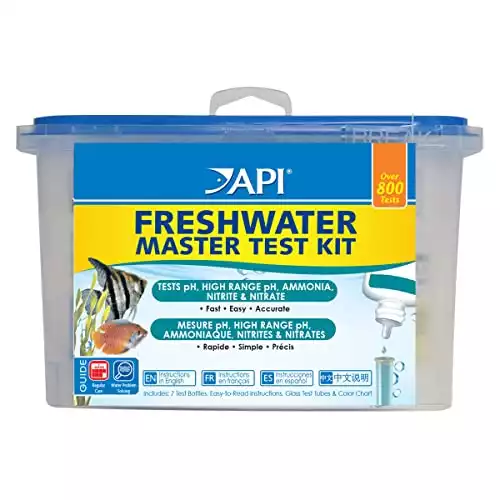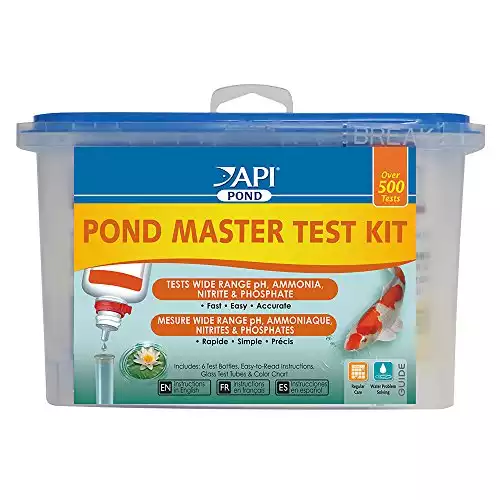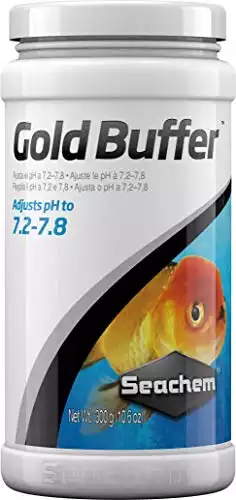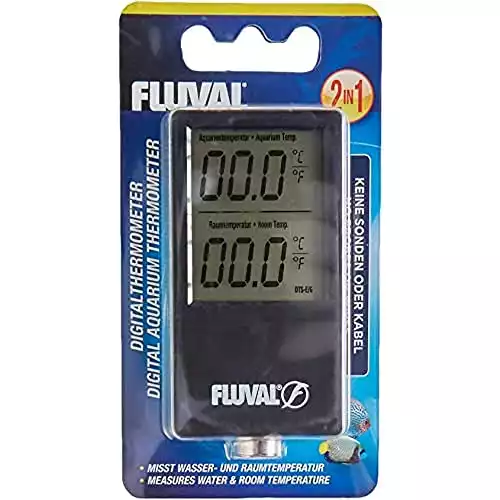
Caring for goldfish is a fun and rewarding hobby, but knowing the right water parameters is important to ensure their health.
Many newbies skip researching this part and wonder why their goldfish is belly up within 2 weeks!
Here’s a simple guide for beginners that covers all the essential parameters you need to monitor.
Goldfish Water Parameters Chart
The 5 essential Goldfish parameters are:
| WATER PARAMETER | TARGET |
| Common / Comet / Shubunkin Goldfish Optimum Temperature | 64°-70°F (17.5°-21°C) |
| Fancy Goldfish Optimum Temperature | 68°-74°F (20°-23°C) |
| pH Level | 7.0-8.0 (7.2-7.6 ideally) |
| Ammonia | 0ppm |
| Nitrite | 0ppm |
| Nitrate | Below 40ppm |
Best Water Test Kit For Goldfish
Maintaining a healthy environment for your goldfish is essential, whether it lives in a tank or a pond.
The best way to measure the water parameters for goldfish is by using a water test kit.
A good goldfish water test kit should include tests for the most crucial water parameters such as ammonia, nitrite, nitrate, and pH.
Liquid tests are more accurate than paper test strips, I’ve used the API Freshwater Kit for years, yes, it’s a bit more fiddly than dipping a piece of paper in the water, but it’s worth it for accurate results and you can perform 800+ tests from 1 kit, so it’s excellent value.
If your goldies live in a tank, the best of the best test kit is the API Freshwater Master Test Kit.
The API freshwater test kit offers outstanding value (over 800 tests!) and is very accurate, if you're serious about fishkeeping this is the best test kit to buy and the only one I use.
- Includes 7 bottles of testing solutions, 1 color card, and 4 tubes with caps.
- Performs over 800 tests.
- Accurately monitors the 5 most vital water parameter levels in freshwater aquariums: pH, high range pH, ammonia, nitrite, and nitrate.
- Helps monitor water quality and prevent invisible water problems that can be harmful to fish and cause fish loss.
- More time consuming than test strips
If your fish live in a pond you’re going to want the API Pond Master Test Kit.
The API pond master test kit offers outstanding value (over 500 tests!) and is very accurate. If you're serious about keeping fish in a pond, this is the best test kit to buy.
- Includes 6 bottles of testing solutions, 3 color cards, and 4 tubes with caps.
- Performs over 500 tests.
- Accurately monitors the 4 most vital water parameter levels in ponds: wide range pH, ammonia, nitrite, and phosphate.
- Helps monitor water quality and prevent invisible water problems that can be harmful to fish and cause fish loss.
- More time consuming than test strips
To use a goldfish water test kit, follow these simple steps:
- Collect a water sample: Use the test tubes included in the kit and add water from your goldfish tank or pond.
- Perform the tests: Follow the instructions on the test kit and add the required number of drops into the sample. Make sure to shake the solutions thoroughly beforehand, as instructed.
- Wait for results: Give the tests some time to react, as specified in the instructions.
- Record the results: Note down the color changes and compare them with the provided laminated color chart to identify the parameter levels in your water.
Test your water regularly, ideally once a week, and keep a record of the results.
This way, you can detect changes in the water parameters early and take appropriate action to prevent potential harm to your goldfish.
Keeping a log of your test results can also be beneficial, as it helps you track the water condition trends over time.
When you notice any deviations in the water parameters, take corrective measures immediately.
For instance, if ammonia, nitrite, or nitrate levels spike, performing a partial water change will help reduce the levels before they get dangerously toxic.
If the pH level is off, adding appropriate products will help bring it back to the desired range.
The 5 Essential Goldfish Water Parameters To Monitor
Here are the five most essential measurements you should be testing for regularly to ensure a safe and healthy environment for your goldfish.
1. Ammonia – NH3
Ammonia is a byproduct of goldfish waste and leftover food decaying.
High ammonia levels are extremely toxic to fish, causing stress, disease, and even death.
To prevent ammonia poisoning, regularly test your water for ammonia levels.
You should have an ammonia level of 0 ppm.
Regular water changes, a quality filter, and removing any leftover food will help reduce ammonia build-up.
2. Nitrite – NO-2
The presence of nitrite in your goldfish tank occurs during the nitrogen cycle when beneficial bacteria (Nitrosomonas) convert ammonia to nitrite.
However, nitrite is also toxic to fish and can result in nitrite poisoning.
You should have a nitrite level of 0 ppm.
Regularly changing water and maintaining good water quality can help manage nitrite levels.
3. Nitrate – NO-3
Nitrate is the next step in the nitrogen cycle when bacteria (Nitrobacter) convert nitrite to nitrate.
Although nitrate is far less toxic than ammonia or nitrite, it can still cause health problems for your goldfish when levels are too high.
Ideally, nitrate levels should be below 40 ppm.
To keep nitrate levels low, perform regular water changes, you can also add some live plants which will feed off and absorb excess nitrates in the water.
African Ferns, Anubias, Crinum, Duckweed, and Java Ferns are among the best plants for goldfish tanks.
If you’re struggling to bring ammonia, nitrite, or nitrate levels down, you can dose with Seachem Prime to help bring them under control, while you figure out what’s causing the issue.
4. pH
pH measures the acidity or alkalinity of water.
Goldfish prefer neutral to slightly alkaline water, 7.2-7.6 is ideal, but they will be okay in 7.0-8.0.
Maintaining appropriate pH levels is important for your goldfish’s well-being.
pH of water is measured on the following scale:
- Neutral: 7.0
- Acidic: 6.9 and below
- Alkaline: 7.1 or above
Regularly testing pH levels and adjusting accordingly can help ensure a stable and healthy environment for your goldfish.
If you need to increase the pH level, you can add some crushed coral to your tank or dose with Seachem Gold Buffer.
Gold Buffer is a non-phosphate buffer that will maintain the ideal pH for goldfish while not enhancing algae growth.
Depending on the dosage, Gold Buffer raises pH and buffers between 7.2 and 7.8.
Use 1 level teaspoon for every 10 gallons (40 liters) daily until the desired pH is reached.
If water is soft or not well buffered, use half dose.
It may be added directly to the aquarium.
- Made in the USA
- High quality
- Can be added directly to your aquarium water
- Dissolves fast
- Safe for aquarium plants
- Raises pH level only, doesn't lower it
There are many ways to easily and safely lower the pH level in an aquarium.
It’s more important to have a consistent pH rather than trying to chase the perfect number.
5. Water Temperature
As cold-water fish, common goldfish thrive in a lower temperature range, their fancy cousins need warmer water to thrive.
Consistently monitoring and maintaining the water temperature is vital for their health so use a reliable thermometer to check the temperature.
Wireless technology means you can mount the thermometer to the outside of the aquarium without any messy probes or wires.
- Well made
- Accurate
- No messy probes or wires
- 2-in-1 design measures water and room temperatures
- Large display simultaneously shows aquarium and ambient room temperatures
- Easy-to-read LCD display
- °F and °C temperature selection
- Battery not included - requires x1 LR44
You should be aiming for:
- Common, Comet & Shubunkin Goldfish: 64°F to 70°F (17.5°C to 21°C)
- Fancy Goldfish: 68°F to 74°F (20°C to 23°C)
If you live in a cold area and need a heater to keep the water temperature in the ideal range, I swear by the Fluval E-Series, I’ve used them for years.
To help you pick the right heater for your tank, check out the chart below:
| TANK SIZE | WATTAGE REQUIRED |
| 20 Gallons | 50 Watts |
| 30 Gallons | 100 Watts |
| 65 Gallons | 200 Watts |
| 100 Gallons | 300 Watts |
If you live in a warm area you may need to buy an aquarium chiller or fans to keep the water cool.
By regularly testing these water parameters, you’ll give your goldfish a healthy environment in which they can flourish!
Poor Water Quality Consequences
Poor water in your goldfish tank will stress your fish.
Stressed fish have a lowered immune system and this makes them vulnerable to illness and diseases such as:
You may also notice your goldfish laying on the bottom of the tank gasping, which can be a sign of poor water quality or low oxygen levels.
If you establish and keep up with a regular tank maintenance schedule, you’ll greatly increase your chances of avoiding the above diseases.
Summary of Water Parameters in Your Goldfish Tank
You now have everything you need to know about ideal water parameters for goldfish.
To help your goldfish thrive, keep an eye on:
- pH levels: Goldfish prefer a stable pH, between 7.0 and 8.0. Make sure to test the water regularly and adjust as needed.
- Temperature: Although goldfish can survive in a wide range of temperatures, they do best when kept between 64°F and 74°F (17.5°C and 23°C) depending on the type of goldfish.
- Beneficial bacteria: These tiny organisms help break down toxic waste in the tank, maintaining a healthy environment. Ensure your filtration system supports a healthy colony of nitrifying bacteria.
- Filtration: A powerful and efficient filtration system is a must-have. It helps remove harmful toxins and supports the growth of beneficial bacteria.
Aside from these key water requirements, there are other steps you can take to keep your goldfish healthy:
- Set up your goldfish tank correctly.
- Regularly change the water to avoid toxin build-up.
- Monitor the tank for signs of excessive algae growth and clean your aquarium as needed.
- Feed your goldfish a balanced and nutritious diet to support their health.
If you follow these guidelines you will get to spend many years with your goldfish, like I did with my first goldfish Moby.
Check out the aquarium health section for more guides like this and keep your tank in tip-top shape.




